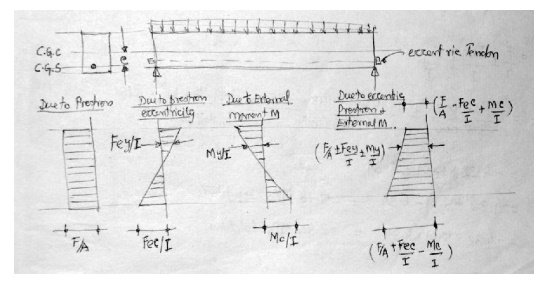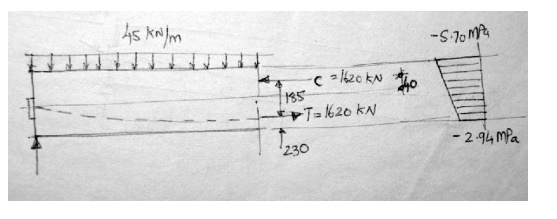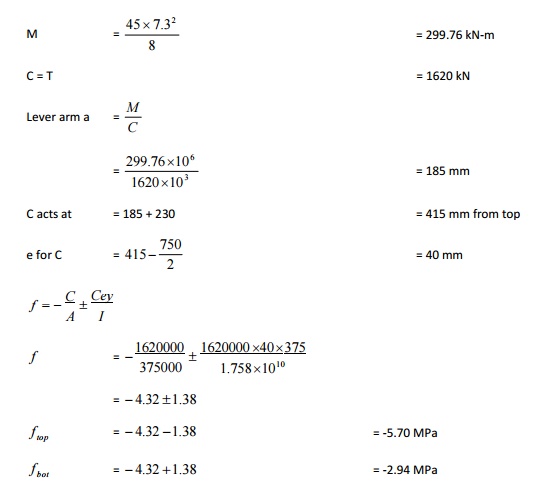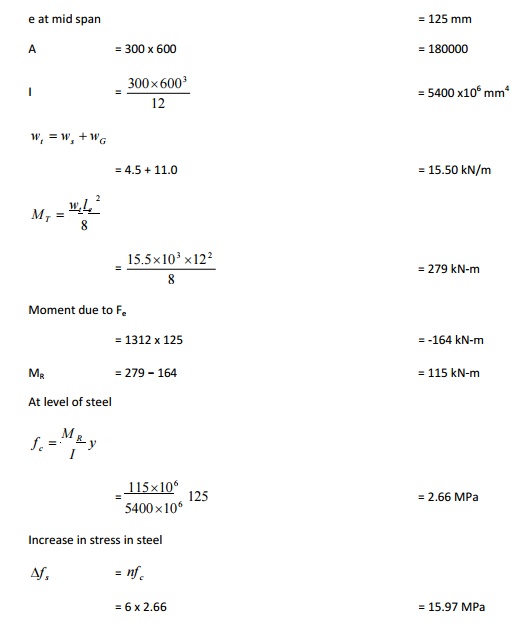Chapter: Civil : Prestressed Concrete Structures : Design Concepts
Prestressed Concrete Structures: Analysis of beam section- concept

Analysis of beam section - concept
Sign convention
1. Tension is (+)
2. Compression is (-)
Different concepts
Different concepts can be applied to
the analysis if PSC concrete beams, namely
1. Pre-stressing transforms concrete
into an elastic material.
2. Pre-stressing is a
combination of high-strength steel and concrete.
3. Pre-stress balances
loads.
Elastic material
This concept treats concrete as an
elastic material and is the most common among engineers. Here concrete is
visualized as being subjected to:
1. Internal pre-stress
2.
External loads.
So long as there are no cracks in the
section, the stresses, strains and deflections of the concrete due to the two
systems of forces can be considered separately and superimposed if needed.
Due to a tensile pre-stressing force
F, thee resulting stress at a section is given below.

The concrete stress at a section due
to pre-stress f is dependant only on the magnitude and location of pre-stress
at that section, ie., F and e, regardless of how the tendon profile varies
elsewhere along the beam.

Ex 1
A pre-stress concrete rectangular
beam of size 500 mm x 750 mm has a simple span of 7.3 m and is loaded with a
udl of 45 kN/m including its self-weight. An effective pre-stress of 1620 kN is
produced. Compute the fiber stresses in concrete at mid-span section.


High strength steel and concrete
This considers the pre-stressed
concrete as combination of steel and concrete similar to RCC. Tension exists in
steel and compression in concrete. These two form a internal resisting couple
against external moment produced by loads.

[Note: Stresses are calculated with
force and eccentricity in concrete. e is the eccentricity of C, the compressive
force in concrete.]

Ex 2
Solve Ex.1 using this concept.


Load balancing
The effect of pre-stressing is
considered as the balancing of gravity loads so that the member under bending
will not be subjected to flexural stresses under a given loading condition.




Analysis of beam section for flexure
Stress in concrete and steel due to pre-stress only

Example - Pre-tensioned member - concentric tendon
A pre-tensioned beam of size 200 mm x
300 mm is concentrically pre-stressed with 520 mm2 wires anchored to
bulkheads with a fi = 1035
MPa. Assuming n = 6, compute the stresses in concrete and steel immediately
after transfer due to pre-stress only.

Example - Pre-tensioned member - eccentric tendon
A pre-tensioned beam of size 200 mm x
300 mm is eccentrically pre-stressed with 520 mm2 wires anchored to
bulkheads with a fi = 1035 MPa. The cgs is 100 mm above the bottom of the beam.
Assuming n = 6, compute the stresses in concrete and steel immediately after
transfer due to pre-stress only.



Which show that the approximate
method is fast and quite accurate.
Example - Post-tensioned member - eccentric tendon
A post-tensioned beam of size 200 mm
x 300 mm is eccentrically pre-stressed with 520 mm2 wires stressed
to a fi = 1035 MPa. The cgs is 75 mm above the bottom of the beam.
Immediately after transfer the stress reduces by 5% owing to anchorage and
other losses. The size of the duct is 50 mm x 75 mm. Compute the stresses in
concrete and steel immediately after transfer due to pre-stress only.


Stress in concrete due to pre-stress & loads
Stresses in concrete produced by
external bending moment, whether due to the beam's self-weight or applied load
is:

The resulting stress in concrete due
to both the pre-stress and loads is:

Example - Post-tensioned member with loads
A post-tensioned beam of size 300 mm
x 600 mm and le = 12 m is pre-stressed with1575 kN which eventually reduces to
1350 kN due to losses. The cgs is 175 mm above the bottom of the beam. The beam
carries two live loads of 45 kN each in addition to its self-weight of 4.5
kN/m. Compute the extreme fiber stresses at mid-span for (a) initial condition
with full pre-stress and no live load and (b) pre-stress after losses with full
live load.


Example - Post-tensioned member with loads
Solve Ex by locating the center of pressure C for
concrete section.

Stress in steel due to loads
In RCC members, the lever arm between
the resultant compression and tension remains almost constant but the tension
in steel increases almost proportionately with increasing moment till yielding.
In pre-stress concrete resistance to
external bending moments is furnished by a lengthening of the lever arm between
the resisting forces C and T which remain relatively unchanged in magnitude.

After cracking, the stress in
pre-stressing steel increases rapidly with moment.
The following sketch explains the variations
of the stress in pre-stressing steel f p with increasing load.
The variations are shown for bonded
and un bonded tendons.
After the pre-stress is transferred
while the member is supported at the ends, the stress will tend to increase
from the value after losses f po due to the moment under self
weight. Simultaneously the stress will tend to drop due to the time dependent
losses such as creep, shrinkage and relaxation. The effective pre-stress after
time dependent losses is denoted as f pe
Due to the moment under service
loads, the stress in the pre-stressing steel will slightly increase from fpv
. The increase is more at the section of maximum moment in a bonded tendon as
compared to the increase in average stress for an un bonded tendon.
The stress in a bonded tendon is not
uniform along the length. Usually the increase in stress is neglected in the
calculations under service loads. If the loads are further increased, the
stress increases slightly till cracking.
After cracking, there is a jump of
the stress in the pre-stressing steel. Beyond that, the stress increases
rapidly with moment till the ultimate load. At ultimate, the stress is f pu
.
Similar to the observation for
pre-cracking, the average stress in an un bonded tendon is less than the stress
at the section of maximum moment for a bonded tendon.
As discussed above, at the section of
maximum moment, the stresses in the un bonded tendon increases more slowly than
that for bonded tendon. This is because any strain in an un bonded tendon will
be distributed throughout its entire length.
If MR is the resultant moment in at a
cross-section of a bonded beam and the beam deflects downwards, there is an
increase in steel stress due to this bending given by


Example - stress in steel
A post-tensioned beam of span le = 12
m and size 300 mm x 600 mm, carries a superimposed load of 11 kN/m in addition
to its own weight of 4.5 kN/m. The initial pre-stress in steel is 950 MPa and
reduces to 820 MPa after all losses and assuming no bending in beam. The cable
of are 1600 mm2 is parabolic. N=6. Compute the stress in steel at
mid-span assuming (a) the steel is bonded by grouting and (b) the steel is un
bonded and entirely free to slip.


Cracking moment
Moments producing first crack in a
pre-stressed concrete beam, assuming cracks start when tensile stress in the
extreme fiber of concrete reaches its modulus of rupture, fcr ,

Example
For the problem in 6.3.1 compute the
total dead and live load that can be carried by the beam for (a) zero tensile
stress at bottom fiber and (2) cracking in the bottom fiber assuming f cr=
4.2MPa and Fe =
1350 kN.


Related Topics